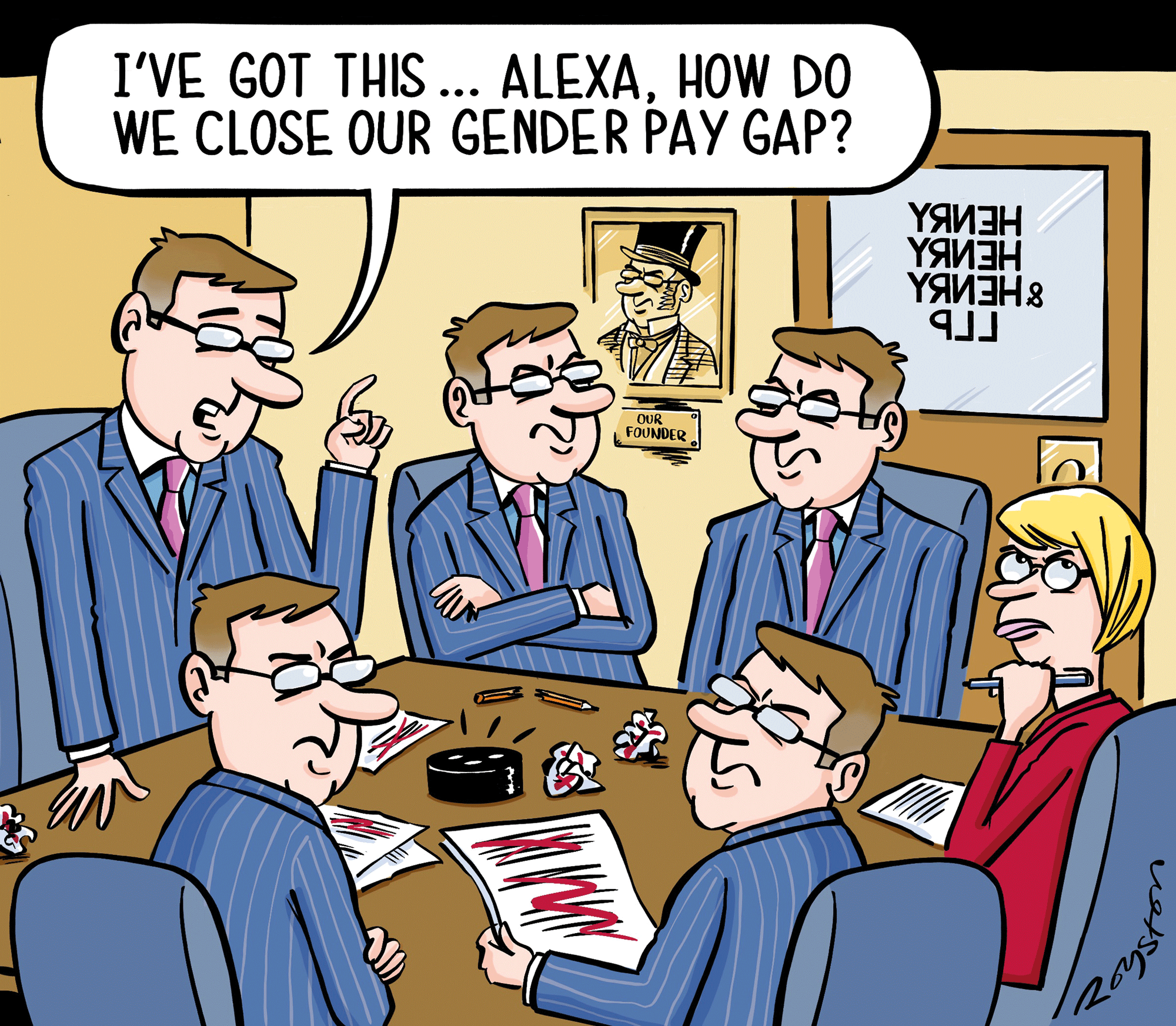The purpose of legislation that requires businesses with a headcount of 250 people or more to disclose gender pay gap data is not to enforce an annual round of self-flagellation. The transparency that gathering and publishing information provides aims at driving change.
Yet the response of some elite firms to the first year of mandatory reporting, in 2018, was to meet the letter, but not the spirit, of the law. While equity partnership in such firms is the glittering prize that many junior lawyers aim for, some firms excluded partner earnings from their first report.
Slaughter and May, for example, reported a median pay gap of 38.5% – but its exclusion of partners earned the firm derision in parliament and the press. In 2019, suitably chastened, the firm included partners – and the gap jumped to 63.6%. In common with many firms, Slaughter and May also chose to measure its race and ethnicity gap (51.1% in 2019).
Addressing the gender pay gap is about taking an honest look at accurate data and seeking to understand why such a gap exists
Catriona Watt, Fox & Partners
Motivation
The decision to publish a lower figure, excluding partners, was not necessarily cynical. For some firms, the thinking ran like this: the firm wants a more diverse intake, whose most talented members can be mentored and supported to partnership. But if the firm’s pay gaps give the impression it does not take diversity and equality seriously, the very people it needs to attract will be deterred.
That is a well-intentioned mistake, Kingsley Napley’s employment head Corinne Aldridge tells the Gazette. Instead, reporting means that ‘every year, you need to address your mind to it’, she points out.
It is, others note, an area where even well-run and well-intentioned organisations did not previously engage with transparent reporting. Funke Abimbola, former general counsel at Roche and now chief executive and founder of diversity and inclusion advisers the Austen Bronte Consultancy, recalls that Roche did not report on its gender pay gap before UK legislation required this. Across the corporate world, she adds, ‘gender reporting has made a big difference’.

Four-point plan
The Government Equalities Office sets out a four-point plan for organisations to close a gender pay gap.
1. Analyse data and identify actions: This focuses on the root causes of an organisation’s gender pay gap, and suggests that every stage within the employee life cycle should be considered to identify any barriers, to ensure that adopted actions can be individually targeted to produce effective results.
2. Consult and engage: HR directors are encouraged to assist senior employees (as wide-ranging as possible) in their understanding of proposed gender pay gap action plans in order to gain their full support. It may be useful to highlight case studies from other organisations within the same and different industries and sectors.
3. Revise, assess, and embed your action plan: In order to ensure that an action plan is integrated into the everyday running of the business, the guidance encourages organisations to monitor, report, and evaluate the action plan to drive improvement. Setting specific dates and targets, and appointing a named individual (e.g. a diversity officer) to drive the plan forward may help ensure that the plan is developed appropriately.
4. Allow enough time: The guidance emphasises that the development of an effective action plan is an ongoing process, and is likely to involve ongoing adjustments, which may take a substantial amount of time.
Summary by Catriona Watt, Fox & Partners
More, not less
So what is actually required? The law requires gender pay gap reporting to break down an organisation’s data to include the following calculations:
- The percentage of men and women in each hourly pay quarter;
- The mean (average) gender pay gap using hourly pay;
- The percentage of men and women receiving bonus pay;
- The mean (average) gender pay gap using bonus pay; and
- The median gender pay gap using bonus pay.
A law firm, like any other organisation reporting the minimum, may find it has a gap – and perhaps a very large one, especially if partner remuneration is included.
Arguably, it is neither useful nor beneficial to do the minimum. By collecting more data, the data becomes useful. It may also tell positive stories. When Hogan Lovells reported, the firm was able to relate that within its partnership, while there were fewer women partners than men, those women received around 2% more than the men.
The way initiatives are communicated is very important
Funke Abimbola, Austen Bronte Consultancy
That was a good headline for the firm, demonstrating as it did that its women partners were not siloed in less profitable practice areas.
Crucially, though, with high-quality data you can locate the source of the discrepancies exposed by the broader figures. Aware of this fact, the employment team at City firm Wedlake Bell has been working with pay gap consultancy Spktral. In a joint webinar on tackling race and ethnicity pay gaps, which a growing number of organisations are choosing to report on alongside gender, Spktral chief executive Anthony Horrigan relates that with data: ‘You need different lenses to zoom in and out.’
Horrigan means it should be possible to group or cut the data in different ways. What, for example, happens when your people are grouped by different measures of race and ethnicity, even within genders; and how does hierarchy affect these results?
It is important to know where the ‘stumbling blocks’ are, he adds. If the answer is joining the partnership, that is where action should be focused.
Consider whether positive action is the only way to address the under-representation or disadvantage… could the same outcome be achieved by action that is less likely to result in less favourable treatment of other people?
Richard Isham, Wedlake Bell
On gender, Fox & Partners’ Catriona Watt notes: ‘The gender pay gap in the UK remains close to zero for full-time employees under 40. Therefore, there is a general recognition of the need to tackle the “motherhood penalty”, which can affect women irrespective of whether they actually do take time for child-rearing purposes.’
Race and ethnicity reporting may become mandatory in the future. Abimbola points to the work of the All-Party Parliamentary Group for Governance and Inclusive Leadership. The group’s officers include Labour, Conservative, SNP and cross-bench parliamentarians, and following its own consultation exercise supports mandatory reporting in this area.
As a single designation, ‘BAME’ is of limited use in ‘zooming’ in and out, Horrigan and others note. More useful are separate categories: white; Asian; black; mixed; other.
Positive action
Positive action will not be deemed to be positive discrimination, provided it can meet a ‘proportionality’ test. If that test is met, examples of positive action include the following.
Remedying a disadvantage
- Advertise jobs in publications/outlets that are likely to be accessed by the target group;
- Encourage applications for the target group – for example, ‘older or disabled people are welcome to apply’;
- Provide opportunities exclusively for the target group: internships, open days, work placements.
Meeting different needs
- Provide training exclusively for the target group;
- Create workplace support groups for those with a protected characteristic who may have different workplace needs or experiences;
- Provide support and mentoring for a member of staff who has a protected characteristic.
Encouraging participation from among the target group
- Set targets for participation;
- Provide bursaries to help the acquisition of qualifications from the target group;
- Outreach work to raise awareness of potential opportunities within the local community;
- Reserve places on training courses, provision of mentoring or provide targeted networking opportunities.
Examples provided by Richard Isham, Wedlake Bell
Action
Watt points to four broad areas for action set out by the Government Equalities Office (see box). These include data analysis, work with senior figures, and steps to ‘embed’ and review an action plan.
The dominant business structure in law remains partnerships. What seems clear is that, in many firms, the disparity between the rewards of partnership and other roles chiefly accounts for law’s pay gaps.
As Aldridge points out: ‘More women are coming into the profession than men.’ Below partnership, she observes, ‘you have more equality. The obvious thing is at the top… The way to bring that [gap] down is to expand the number [of senior women]’ .
‘My view,’ Watt says, ‘is that addressing the gender pay gap is about taking an honest look at accurate data and seeking to understand why such a gap exists.’ It is evident, she adds, that ‘a lack of women in senior leadership roles is the root cause of the gender pay gap, so looking at the potential barriers to female progression and committing to fostering a culture which allows women to thrive, along with mentoring and championing schemes, is a step in the right direction’. Whatever the plan is, she says, it ‘needs to be embedded in the culture of the firm and at every level for real change to begin’.

When there is a plan, ‘who owns it?’ Aldridge asks. ‘Senior management needs to set the standard, [as] for everything else.’ Others agree. ‘This is not just HR’s role,’ Abimbola stresses. ‘The responsibility should sit ‘at a very senior level’.
Those senior people will need to engage with more than the gender pay gap regulations. Equality and diversity initiatives often encounter responses that range from scepticism to distrust – and when personal data is sought, sometimes outright hostility. As a result, Abimbola advises: ‘The way it’s communicated is very, very important.’
‘For cultural change, you need people’s buy-in,’ Aldridge says. To achieve that, it is helpful if a firm has networks for staff and partners who share different characteristics. These groups are useful when it comes to communicating the purpose of initiatives to address a pay gap. Kingsley Napley, Aldridge notes, has ‘lots of separate groups within the firm. They will [both] challenge and embrace behaviours’.
If a firm does not already have complete data on race, ethnicity and cultural heritage, the way it communicates the decision to gather that data is also important. Wedlake Bell partner Richard Isham says a ‘fear of saying the wrong things’ is a common obstacle to important dialogue. The solution is to ‘keep abreast of the vocabulary’.
Discrimination?
Good communication becomes particularly important as a firm takes steps aimed at closing its pay gaps, as this may involve ‘positive action’. Positive action is commonly confused or conflated with ‘positive discrimination’ in debates on equality and diversity. But the distinction is important, as positive discrimination is illegal.
In law, Isham notes, positive discrimination is the act of ‘favouring’ someone who has one or more of the protected characteristics set out in the Equality Act 2010, without regard to the merits of the candidate. These are age, disability, gender reassignment, marriage or civil partnership, pregnancy and maternity, race (including ethnic or national origins, colour and nationality), religion or belief, sex and sexual orientation.
‘Positive action,’ Isham continues, ‘is lawful under the Equality Act.’ Such action covers voluntary measures which the employer can take to improve equality and representation for people who share one or more of the protected characteristics.
Broadly, positive action covers recruitment and promotion, and encouragement and training. It can be linked to measures such as a guaranteed interview scheme for particular target groups.
Under the law, positive action allows an employer with two or more candidates for a role to recruit or promote a candidate from a group or groups ‘that the employer has identified as facing a disadvantage or which is under-represented in its workforce’, Isham explains. But only if ‘the candidates are of equal merit’ and ‘the employer is satisfied that their decision is proportionate’.
Encouragement and training targeted at people who share a protected characteristic can also be deployed, provided the employer has credible evidence that people who share a protected characteristic experience a disadvantage, have different needs, or have a disproportionately low participation in an activity carried on by the employer.
Proportionality
Positive action applied to recruitment and promotion, or to encouragement and training, is subject to a ‘proportionality’ test. That is a reason to take legal advice on plans that include positive action steps. Knowing that positive discrimination and positive action are different may not be enough.
One danger area is recruitment and promotion – if the requirements set out for a job are too low for the role, for example, appointing a candidate with a protected characteristic ahead of another, with reference to the role’s requirements being equally met, may be illegal.
‘Proportionality,’ Isham says, ‘requires a balancing of all relevant factors – for example, consider whether the proposed positive action is the only way to address the under-representation or disadvantage… could the same outcome be achieved by action that is less likely to result in less favourable treatment of other people?’
If a proportionality test can be met, positive action can start with advertising vacancies in publications or outlets likely to be accessed by the target group. An organisation can specifically ‘welcome’ applications from target groups. Opportunities can also be provided exclusively to members of a target group – such as open days or internships.
Targets can be set for the participation or promotion of target groups. Extra assistance can be provided to this end, including bursaries for professional qualification. Reserved places on training courses, provision of mentoring or targeted networking opportunities are also allowed.
Covid-19
Some good things could come out of the way we responded to the virus, it has been suggested. There has, in many instances, been much greater honesty around the caring responsibilities that professionals juggle with work, and a need to accommodate such needs.
That has been seen to help, not hinder, the resilience of the profession at a testing time. With a disproportionate burden of caring responsibilities borne by women, might this help tackle the ‘motherhood penalty’ identified by Watt? The enhanced caring responsibilities added by lockdown have, after all, been balanced with a maintenance of output and standards, made possible by honest conversations within teams.
Lawyers with disabilities have long argued that better use of technology and remote and flexible working were needed to allow them to progress their careers. For them, arguments over whether such necessary accommodations can be made were won almost overnight. And there will be professionals who have acquired a protected characteristic – disability – as they are now living with the effects of long-Covid.
‘With the pandemic, people have worked differently,’ Aldridge notes. That has included ‘lots of thinking about mentoring and monitoring’ and about ‘fair distribution [of work]. Also about being more supportive – especially of females. How we work with working families, and much more about a more inclusive environment.’
If that is the case, has a legal requirement on gender pay gap reporting, and the prospect of mandatory race, ethnicity and disability reporting, been overtaken by events?
Despite the dramatic events of the past year, progress needs to be supported and sustained by the hard instrument of the law. ‘The Equal Pay Act was passed in 1975,’ Aldridge observes. ‘Yet we still have substantial differences, especially in the City and insurance sector.’ The largest firms are ‘just another part of that’. Pay gaps, therefore, will continue to demand their attention.
Further resources
Gender pay gap reporting, guidance for law firms, the Law Society
Ethnicity pay gap analysis, webinar by Wedlake Bell and Spktral





































2 Readers' comments